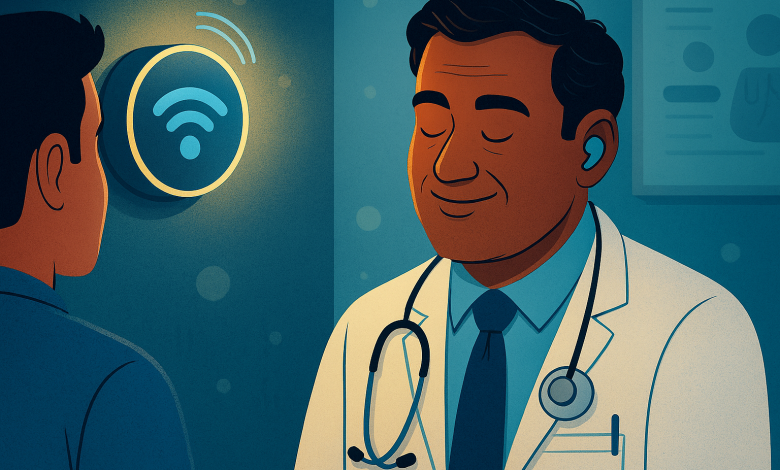
In podiatric medicine, patient care is paramount. However, many healthcare providers find their focus diminished by the daily demands of documentation, note-taking, and navigating electronic health records (EHRs). As the President and Chief Medical Officer at a podiatry practice, I’ve watched technology both help and hinder the interaction between patient and physician, and understand what is needed for good clinical care.
Today, that is changing. At our practice, ambient listening artificial intelligence is closing the distance between the doctor and the patient, supporting a clinical environment where the focus is on people, not paperwork. Let me walk you through exactly how we’re using this technology, why it matters, and what lessons the broader healthcare community can take from this transformation.
Anyone who’s ever worked in medicine knows that documentation can drain the “sole” of any podiatrist. Every appointment is followed by a flurry of typing, clicking, and checking countless boxes. This often adds hours to a provider’s day. In podiatry, we have multidisciplinary aspects that involve biomechanics, surgery, wound care, and patient education. This makes thorough records mandatory. However, there is a real cost. By the end of each clinic day, energy that could have gone into the next patient is rerouted into the computer screen.
Podiatrists, like colleagues across healthcare, have become “the highest-paid clerical workers in the world.” Doctors using EHR often struggle to meet documentation requirements. This is not just inefficient; it directly impacts the quality of healthcare, the morale of clinicians, and, ultimately, the patient’s experience. When it comes to documentation for Medicare, perfection is the standard. One item missing can result in a payment recoupment. Who likes working for free?
Ambient listening AI represents a next-generation voice recognition technology. It quietly “listens” to provider-patient conversations as they occur. Utilizing always-on audio capture, advanced speech recognition, and natural language processing, the system takes the live clinical dialogue, identifies speakers, extracts key clinical data, and generates structured notes in real time.
Unlike legacy dictation tools, these AI systems operate completely passively in the background and require no specific instructions or prompts. The AI transcribes and understands conversation context, turning it into medical documentation. Most importantly, the provider remains in command, reviewing and editing clinical notes before they become permanent parts of a patient’s medical record.
At our practice, we wanted to make the leap from traditional documentation to an approach that respects both the clinician’s workflow and the patient’s dignity. Today, every clinic room at our practice is equipped with the technology needed for ambient listening.
Here’s how the process works:
As the consultation unfolds, the AI listens to the history-taking, physical exam, and patient questions in real time.
The system recognizes when the provider or patient is speaking, tagging clinical context such as symptoms (“burning foot pain”), medications, diagnoses, and plans (“recommend custom orthotics and follow-up in two weeks”). A draft note is automatically organized and delivered for quick review, editing, and sign-off by the provider at the end of the visit. The final, approved documentation is then integrated into the EHR.
This workflow returns control, time, and attention to where it belongs: the patient encounter.
Benefits We’ve Seen–For Doctors, Patients, and the Practice
1. Transforming the Patient Experience
The moment the laptop closes or the provider’s eyes leave the screen, patient engagement changes. With ambient AI, providers can keep their focus on the person in the chair. This allows for better eye contact, listening more, and performing examinations without interruption. This builds trust and rapport, improves the clarity of communication, and leads to better adherence to treatment plans.
Patients notice: Many patients report feeling truly heard for the first time, as appointments are no longer haunted by the rapid-fire typing or the wait for a provider to “catch up” with documentation.
2. The Clinician’s Perspective: Efficiency and Peace of Mind
Clinicians are experiencing a visible reduction in end-of-day burnout, as after-hours charting simply disappears. Most notes are completed in the exam room, sometimes even before the patient leaves. This leads to more accurate documentation and greater job satisfaction. It also allows for the patient to leave with a clinical summary of the visit, if this is desired.
The AI scribe’s learning capability is crucial. Over time, it adapts to individual providers’ preferences, medical terminology, and even unique podiatric exam language. This ensures that notes feel authentic and maintain our clinical standards.
3. Enhanced Accuracy, Consistency, and Legal Protection:
Ambient documentation produces a more consistent and standardized note. This is a significant benefit for practices under increasing audit pressure. Comprehensive notes, completed simultaneously at the time of the visit, reduce the risk of errors or omissions. Having detailed and time-stamped documentation provides a vital layer of legal protection.
4. Streamlining Interdisciplinary Collaboration:
Because notes are more comprehensive and immediately available, communication among the care team is smoother. Whether discussing wound care, post-surgical recovery, or care coordination for diabetic patients, all pertinent information is at hand from the outset.
5. Improved Compliance and Security:
Leading ambient AI platforms are built with security and compliance as foundational principles. At our practice, our technology is HIPAA-compliant; no audio is stored without consent, and documentation is encrypted from the ground up. Patients are proactively informed about how technology is used and given control over their information, building trust and transparency.
6. Dramatic Cost Savings:
Traditional medical scribes, remote transcription services, or even manual dictation carry substantial overhead. With AI ambient documentation, costs drop considerably. Practices can reinvest saved staff time and dollars into patient care, staff education, or technology upgrades.
Challenges and What to Look for in the Future
No technology transition is without growing pains. Implementation of ambient listening AI in a podiatric practice should be approached carefully. No one likes change.
Patient Consent and Comfort: Patients must be informed and comfortable with technology recording their visits. Transparency is key. Some type of consent should be obtained with every encounter, and the option to ‘pause’ or ‘stop’ should always be available.
Initial Learning Curve: Both clinicians and patients may need a brief adjustment period. Providers must remember to verbalize key findings (“No signs of infection today”) for the system to capture all necessary data.
Review and Edit: AI-generated notes are drafts. Providers retain editorial control to correct, clarify, or expand on any aspect before submitting to the medical record. Similar to proofreading a transcribed note before signing off. This is like before when we received a transcribed note from dictation.
Technical Issues: Like any IT solution, ambient AI platforms rely on uninterrupted connectivity, device maintenance, and ongoing vendor support. Some systems have offline backup systems, and this can be important if your internet goes out.
Still, these challenges pale in comparison to the hourly and emotional grind of manual recordkeeping.
The Bigger Picture: AI Scribes and the Future of Podiatric Care
As more podiatry practices adopt ambient listening, expect major shifts in how clinical care feels from the moment of patient intake onward. Standardization of notes streamlines insurance claims, supports data-driven care, and enhances research and clinical audits.
Perhaps most exciting is the opportunity for ambient listening systems to evolve into even more powerful tools. Issues like flagging medication conflicts, prompting evidence-based recommendations, and auto-generating patient education materials will help increase patient care. The “intelligent assistant” will become a partner in care, not simply a note-taker.
At our practice, adopting ambient listening AI is about more than workflow improvement or cost savings. It is about restoring the human connection in medicine. When technology is carefully chosen and well-implemented, it disappears into the background, allowing clinicians to do what they do best: listen, care, and “heel.”
This approach has improved not just our days in the clinic, but also our relationships with our patients. We invite other practices to consider how humane ambient AI can help bring joy, precision, and humanity back to the practice of healing.




